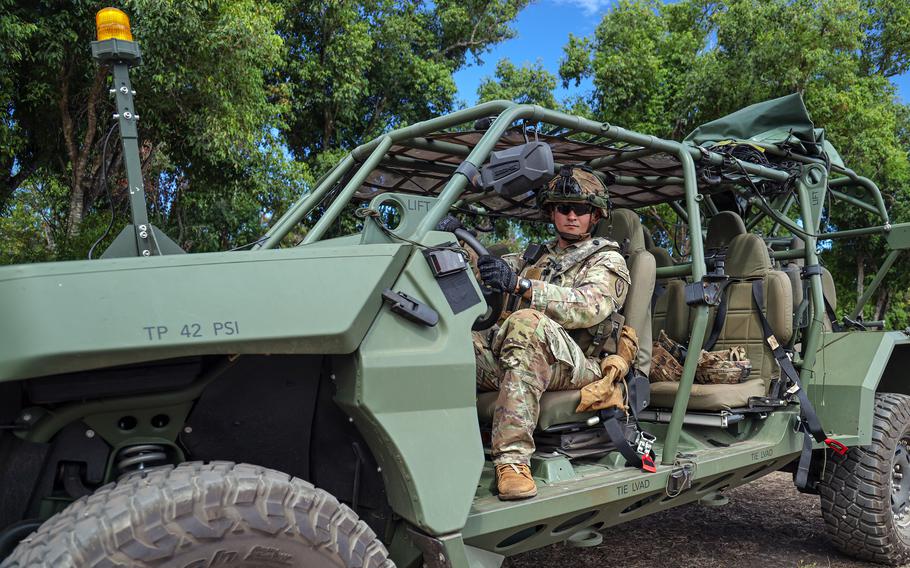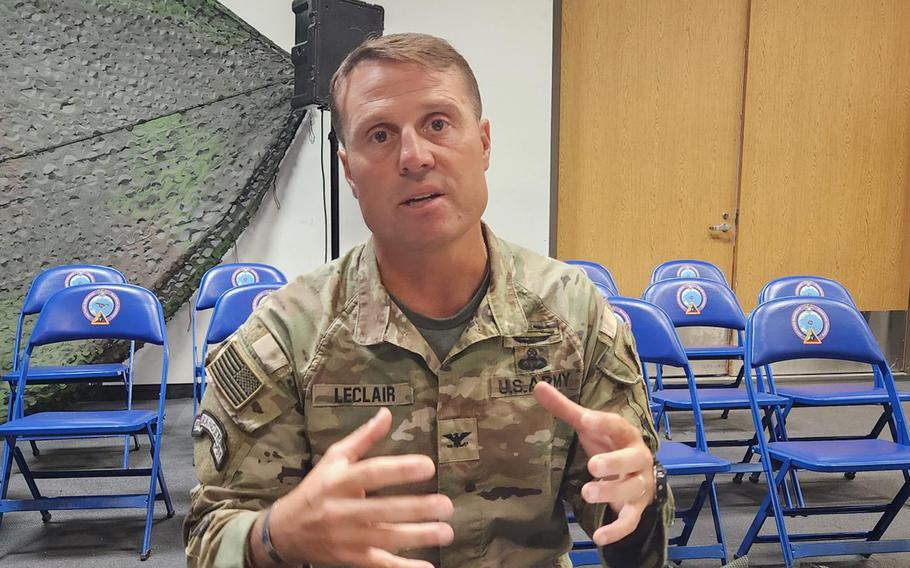
Sgt. Daniel Allen, an infantryman with the 25th Infantry Division, poses in an Infantry Squad Vehicle at Schofield Barracks, Hawaii, Oct. 5, 2024, during a Joint Pacific Multinational Readiness Center combat training exercise. (Brenden Delgado/U.S. Army)
SCHOFIELD BARRACKS, Hawaii — Soldiers of the 25th Infantry Division are testing the Army’s new Infantry Squad Vehicle during a two-week exercise in Hawaii that ends Thursday.
“It’s probably the greatest thing that’s come out of this exercise so far,” Col. Matthew Leclair, commander of the 196th Infantry Brigade, said during an interview Sunday in the combat training command center at Schofield Barracks.
“It’s fundamentally changed how fast we can get infantry from one location to the next,” he said.
The 196th, headquartered at Fort Shafter, oversees training and readiness for U.S. Army Pacific troops and operates the Joint Pacific Multinational Readiness Center’s regional combat training centers in Alaska, Hawaii and at deployed locations across the international date line.
Now in its fourth year in Hawaii, the JPMRC training focuses on one combat unit of the 25th Infantry Division, centering this time on the 2nd Light Brigade Combat Team.
The JPMRC possesses personnel and equipment capable of providing realistic combat training of the kind soldiers would get at the Joint Readiness Training Center at Fort Johnson, La., or the National Training Center at Fort Irwin, Calif.
This year’s Hawaii exercise is in part assessing whether the light brigade combat team has the right equipment and whether the unit is structured appropriately, Leclair said.
“Are they more lethal based on the equipment that we gave them and are they more mobile based on the equipment we gave them?” he said.

Col. Matthew Leclair, commander of the 196th Infantry Brigade, speaks about the Joint Pacific Multinational Readiness Center combat training exercise while in the command center at Schofield Barracks, Hawaii, Oct. 13, 2024. (Wyatt Olson/Stars and Stripes)
The brigade was given 96 Infantry Squad Vehicles for validation during the exercise, a process that has already begun with the 101st Airborne Division, Leclair said.
Validation is when equipment is tested and evaluated to confirm it meets performance and safety standards before it is fully deployed across the force.
The ISV is manufactured by GM Defense, a subsidiary of General Motors. The firm was awarded an initial $214 million contract in 2020 to develop a light and agile all-terrain vehicle that could carry nine soldiers.
It is based on the Chevrolet Colorado ZR2 Bison and powered by a 2.8-liter engine. It is small enough to be loaded into a Chinook or Stallion helicopter and light enough to be sling-loaded under a Black Hawk helicopter, according to an Army fact sheet.
It took the soldiers only a couple of days to figure out how to use the new vehicle, Leclair said.
“It’s really quiet,” he said. “It’s light. It goes forever on one tank of gas, like 400 kilometers. It doesn’t require a ton of maintenance.”
“For years, we’ve had the Humvees,” he said. “For years, we’ve had these big trucks that we’ve loaded infantrymen into the back, 16 to 20 at a time. It’s so loud you can hear it coming from a mile away. It takes hours to load everybody onto these trucks.”
With ISVs, soldiers throw their rucksacks on top of the roll cage, pull a net over them and take off, Leclair said.
“You give three or four of these vehicles to a platoon, and they can be off and gone,” he said.
The ISVs are part of the Army’s “Transforming in Contact” initiative, which aims to rapidly put the newest technology into the hands of soldiers to make them more lethal, survivable and adaptable in any environment.
The concept is being tested using brigade combat teams with the 25th ID, 101st Airborne Division and the 10th Mountain Division, according to an Army fact sheet.